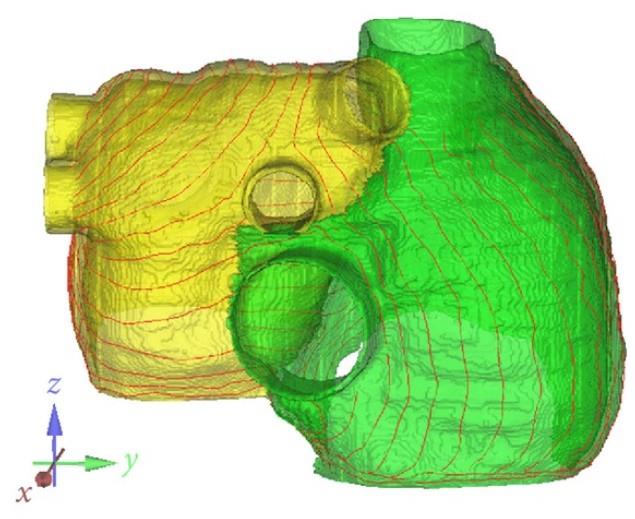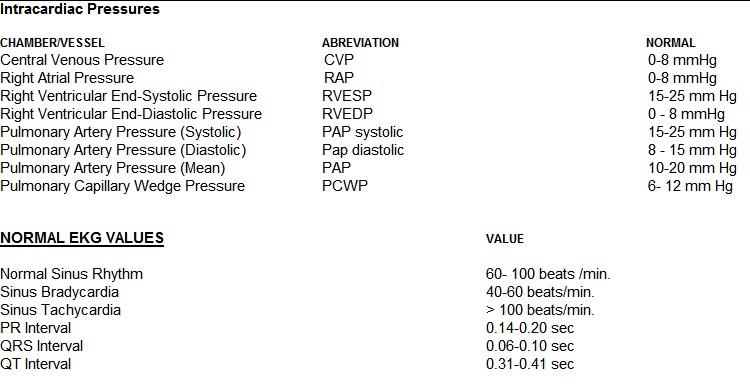Intracardiac Pressures

Intracardiac Pressures
=
Right ventricular systolic pressure
Right ventricular systolic pressure (RVSP) can be easily assessed in most subjects who present some degree of tricuspid regurgitation. The velocity recorded across the regurgitant jet corresponds to the right ventricular-right atrial gradient (RV-RA ΔP), so that, this value added to mean right atrial pressure (RAP) represents the right ventricular systolic pressure:
RVSP = RV-RA ΔP + RAP
Right atrial pressure
The right atrial pressure (RAP) can be estimated from the end-expiratory diameter and respiratory changes of the inferior vena cava (IVC) as follows:
- Normal diameter (≤2,1 cm) and inspiratory collapse (>50%), RAP 3 mmHg (range, 0-5 mmHg)
- Dilated IVC (≥ 2,1 cm) with reduced respiratory variation (<50%), RAP 15 mmHg (range, 10-20 mmHg)
- IVC diameter and respiratory variation unfitting the previous paradigm, without resolving hepatic flow pattern (absence of prevalent systolic or diastolic flow component) or tricuspid E/e’ wave ratio, RAP 8 mmHg (range, 5-10 mmHg)
Pulmonary artery systolic pressure
If there is no obstruction at the right ventricular outflow tract, RVSP equals the pulmonary artery systolic pressure
Pulmonary artery diastolic pressure
Pulmonary artery end-diastolic pressure (PADP) can be estimated in the presence of a well-distinct pulmonary regurgitation flow as follows:
PADP = EDP ΔP + RAP
Mean pulmonary artery pressure
Mean pulmonary artery pressure (MPAP) can be easily derived by systolic and diastolic pressure as:
1/3 PASP + 2/3 PADP.
Left ventricular filling pressure
Left ventricular filling pressure and so atrial diastolic pressure can be estimated using a combination of Doppler parameters. Although mitral inflow Doppler pattern alone allows a first classification of diastolic dysfunction, especially in subjects with reduced systolic function, its dependence on load condition and other factors (i.e. age and heart rate), requires its integration with tissue-Doppler (TD) imaging assessment of left ventricular myocardial velocities, pulmonary venous flow.
References
- Galiuto L, Badano L, Fox K, Sicari R, Zamorano JL. The EAE Textbook of Echocardiography. Oxford University Press, London, 2011.
- Rudsky LG, Lai WW, Afilalo J et al. Guidelines for the echocardiographic assessment of the right heart in adults: a report from the American Society of Echocardiography endorsed by the European Association of Echocardiography, a registered branch of the European Society of Cardiology, and the Canadian Society of Echocardiography. J Am Soc Echocardiogr 2010;23(7):685-713.
- Masuyama T, Kodama K, Kitabatake A, Sato H, Nanto S, Inoue M. Continuous wave Doppler echocardiographic detection of pulmonary regurgitation and its application to noninvasive estimation of pulmonary artery pressure. Circulation 1986; 74:484–492.
- Dabestani A, Mahan G, Gardin JM et al. Evaluation of pulmonary artery pressure and resistance by pulsed Doppler echocardiography. Am J Cardiol 1987;59:662-8.
- Aduen JF, Castello R, Lozano MM et al. An alternative echocardiographic method to estimate mean pulmonary artery pressure: diagnostic and clinical implications. J Am Soc Echocardiogr 2009;22:814-9.
- Nagueh SF, Appleton CP, Gillebert TC, et al. Recommendations for the Evaluation of Left Ventricular Diastolic Function by Echocardiography. Eur J Echocardiogr. 2009;10(2):165-93.


